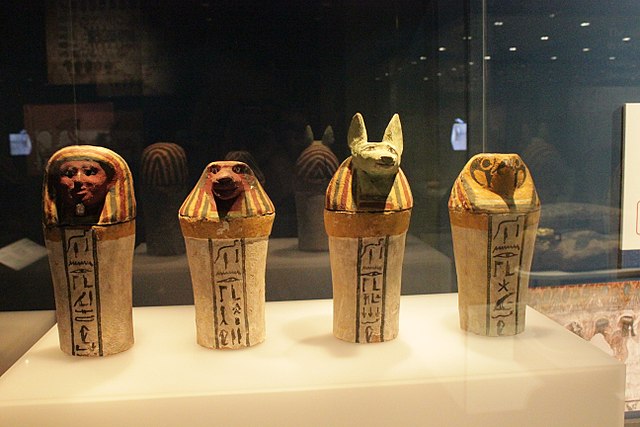Canopic jars are fascinating artifacts from ancient Egyptian culture that played a crucial role in the mummification process and the preservation of organs for the afterlife. These jars, often elaborately decorated and inscribed, held the internal organs of the deceased. Here, we’ll unveil the secrets of canopic jars and their significance:
1. Purpose and Significance:
- Preservation for the Afterlife: Canopic jars were designed to hold the preserved organs of the deceased, which were believed to be essential for the person’s journey in the afterlife. These organs included the liver, lungs, stomach, and intestines.

- Protection: The canopic jars were not only containers but also protective vessels. Each jar was associated with one of the Four Sons of Horus, protective deities who guarded the organs. These deities were:
- Imsety, who guarded the liver and was depicted with a human head.
- Hapi, who guarded the lungs and had the head of a baboon.
- Duamutef, who guarded the stomach and had the head of a jackal.
- Qebehsenuef, who guarded the intestines and had the head of a falcon.
2. Design and Decoration:
- Shape: Canopic jars typically had a square or rectangular base and a lid shaped like the head of the respective deity. The jars were often made of various materials, including limestone, alabaster, or pottery.
- Decoration: The lids of canopic jars were elaborately decorated, often with the head of the deity, hieroglyphic inscriptions, and protective symbols. The jars themselves might also have inscriptions or decorations, indicating the name and titles of the deceased.
3. Process of Mummification:
- Removal of Organs: During the mummification process, the internal organs were carefully removed from the body. The heart was usually left in place because it was considered the seat of intelligence and emotion and was necessary for judgment in the afterlife.
- Preservation: The organs were cleaned, preserved with natron (a natural salt), and sometimes wrapped in linen bandages. They were then placed in the canopic jars.
4. Evolution Over Time:
- In earlier periods of ancient Egypt, the organs were often not preserved in canopic jars but were instead placed directly back into the body after the mummification process.
- Over time, the practice of using canopic jars became more standardized, with each organ designated to a specific jar and associated deity.
5. Modern Discoveries:
- Archaeological excavations have uncovered numerous canopic jars, providing valuable insights into the funerary practices and beliefs of ancient Egyptians.
- Many canopic jars and their contents are now housed in museums around the world, where they continue to be studied and admired.
In summary, canopic jars are essential artifacts in understanding the complex funerary rituals and beliefs of ancient Egypt. They were not only practical containers for preserving organs but also held deep religious and spiritual significance, as they were associated with the protection and guidance of deities in the afterlife. These beautifully crafted vessels provide a window into the rich culture and traditions of ancient Egyptian civilization.









